The total number of horses exiting racing each year, and those bred for racing who never make it to the track are not reported by the New Zealand racing industry.
The purpose of this report is to estimate, as accurately as possible, the number of horses discarded or vanished each year from the New Zealand Thoroughbred Racing (NZTR) industry. This is commonly referred to as ‘wastage.’ Official industry reports are very limited in the information they provide, particularly in terms of data regarding the movement and registration of horses. Reporting on the number of horses imported and exported each year has been very limited in the past and is non-existent in recent years reporting, as are details on where horses go, once they exit the industry.
There are also many inconsistencies between the various New Zealand reports and even larger inconsistencies between New Zealand reported statistics and those from other countries. Therefore, we have had to rely on the limited data provided by the NZTR Fact Book (not produced since 2010) and NZTR Annual Reports, along with statistics from various other sources such as official industry reports from other countries where relevant to New Zealand. It was necessary to obtain data and statistics from several other sources to fill the gaps on information unavailable in the NZTR reports, specifically the NZ Fact Books and Annual Reports. Other resources used include, the New Zealand Studbook, the Australian Racing Fact Book, the International Federation of Horseracing Authorities (IFHA) and figures provided by various other international racing authorities. For example: we took the number of foals bred each year from the NZTR Fact Books and Annual Reports from 2007 – 2019, except for 2016 when we had to take this figure from the IFHA.
Below is the Coalition for the Protection of Racehorses’ best conservative estimate on the number of horses who go unaccounted for by New Zealand Thoroughbred Racing each year. We welcome any further evidence that can possibly be provided on the numbers and whereabouts of these horses.
We consider:
1. The number of individual horses who are used to race each year
plus
2. The number of foals born into the industry each year
plus
3. The number of horses imported each year
minus
4. The number of horses exported each year
minus
5. The number of individual horses who race the following year
The discrepancy found is the number of horses who remain unaccounted for each year, otherwise known as ‘wastage’.
Over 11 years, from the 2007/2008 racing year to the 2017/18 racing year, our research indicates the number of horses unaccounted for each year has been anywhere between 2,459 (2007/08) to 4,165 (2008/09). Overall, the approximate number of New Zealand thoroughbred horses unaccounted for over the 11-year period is 35,105 – averaging 3,191 horses per year.
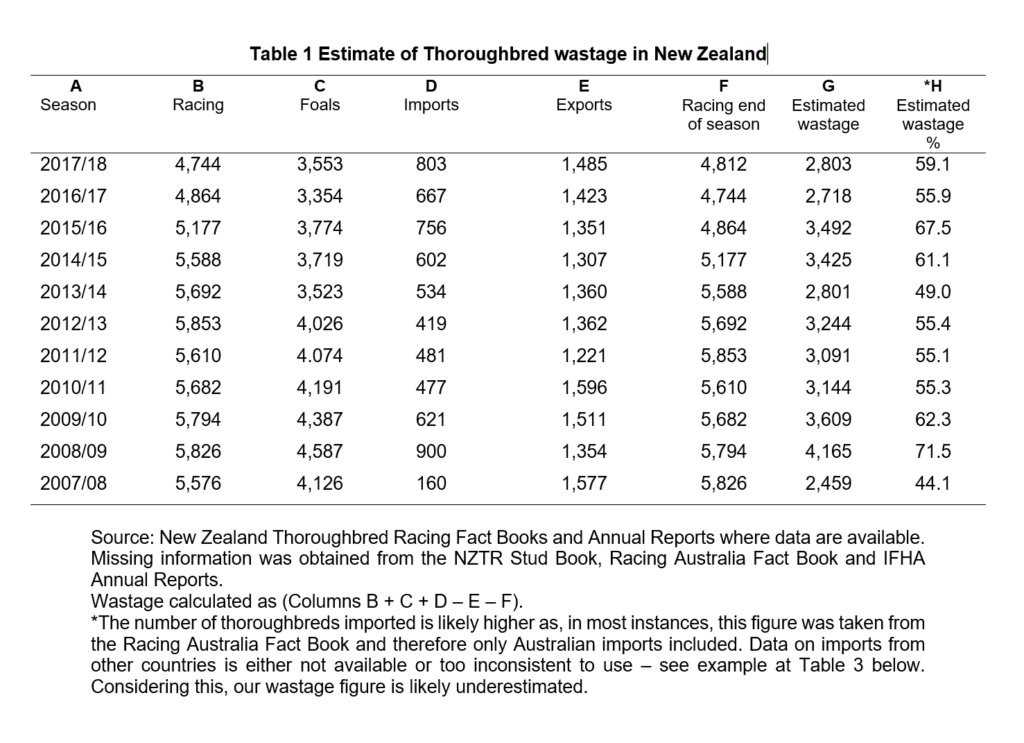
In playing devils’ advocate, one argument against the accuracy of these estimates could be that many of the horses we list as unaccounted for have gone into breeding. There is no doubt some racehorses are sent into the breeding cycle once they are no longer used for racing, however that does not necessarily mean those numbers should be deducted from our wastage figures. As Table 2 below demonstrates, the numbers of NZ racehorses in breeding programs has remained reasonably consistent since 2012/13, meaning that for every mare or stallion added, at least one must have been removed and has therefore become one of the many horses who remain unaccounted for. If anything, to consider the number of racehorses used in breeding when calculating the number of horses who remain unaccounted for by the industry each year, would demonstrate an even higher annual wastage figure as the number of broodmares dropped dramatically between 2007 – 2012 from approximately 8,000 to approximately 5,000. The number of stallions used for breeding dropped from approximately 170 to 130 over the same period.
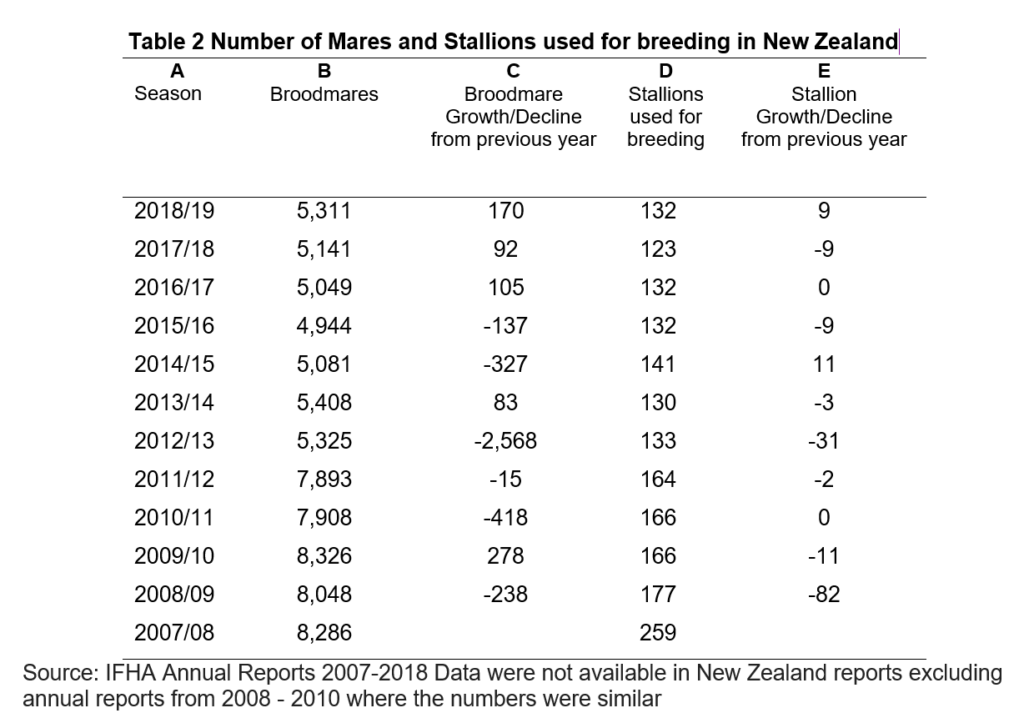
Another argument against these wastage estimates could be that there are many horses in training but not actually racing at any given time. If we used the number of horses in training at the start and end of the season as opposed to the number of horses who were used in races, the outcome would be roughly the same as we would be starting with a higher figure and also deducting a higher figure. We chose to use the number of individual horses who started a race as these figures are reported consistently by the IFHA. Figures regarding the number of horses in training are rarely made available.
Finally, a claim often made by the industry is that thoroughbred horses are sold/re-homed to pleasure and equestrian pursuits. It is of course possible some of these horses are, however, we do not believe this would be the likely outcome for the majority due to the many behavioural issues and injuries that come from being used as a racehorse, that often require dedicated long-term rehabilitation. Furthermore, such issues increase the likelihood of the horse changing hands many times in a short space of time and ending up at a knackery to be killed for pet food. When asking NZTR on the number of ex-racing horses they believe are re-homed they simply did not know.
Below we have included several additional tables that summarise the statistics provided from various industry reports, to highlight the vast inconsistencies in data published between countries and authorities. On reviewing all of the information, it is clear the various countries, including New Zealand, are not effectively tracking the horses they are responsible for at all.
Table 3 shows for example, that for every year, the reported exports from the USA to Australia/NZ combined, exceeded the number of imports reported by Australian authorities alone.
Table 4 shows inaccuracies in the reporting of exports to the USA. For example, in 2018/19 the USA reported 18 imports from Australia/NZ (Col B). Deducting the 10 exports from Australia to the USA (Col C) should leave 8 exports from NZ (Col D), but the NZ Stud book reported no exports (Col F).
Table 5 shows a discrepancy of 621 horses for the 2018/19 year. The Australian Racing Fact Book reported 1,641 imports from NZ, but the NZ Studbook reported only 1,020 exports to Australia.
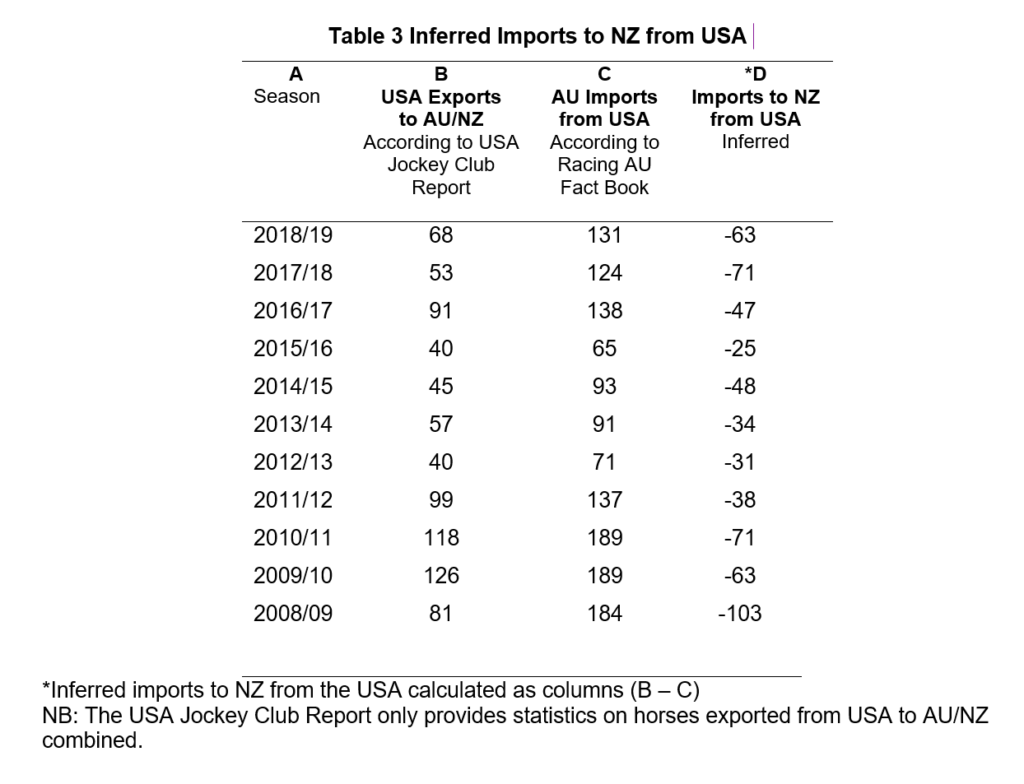
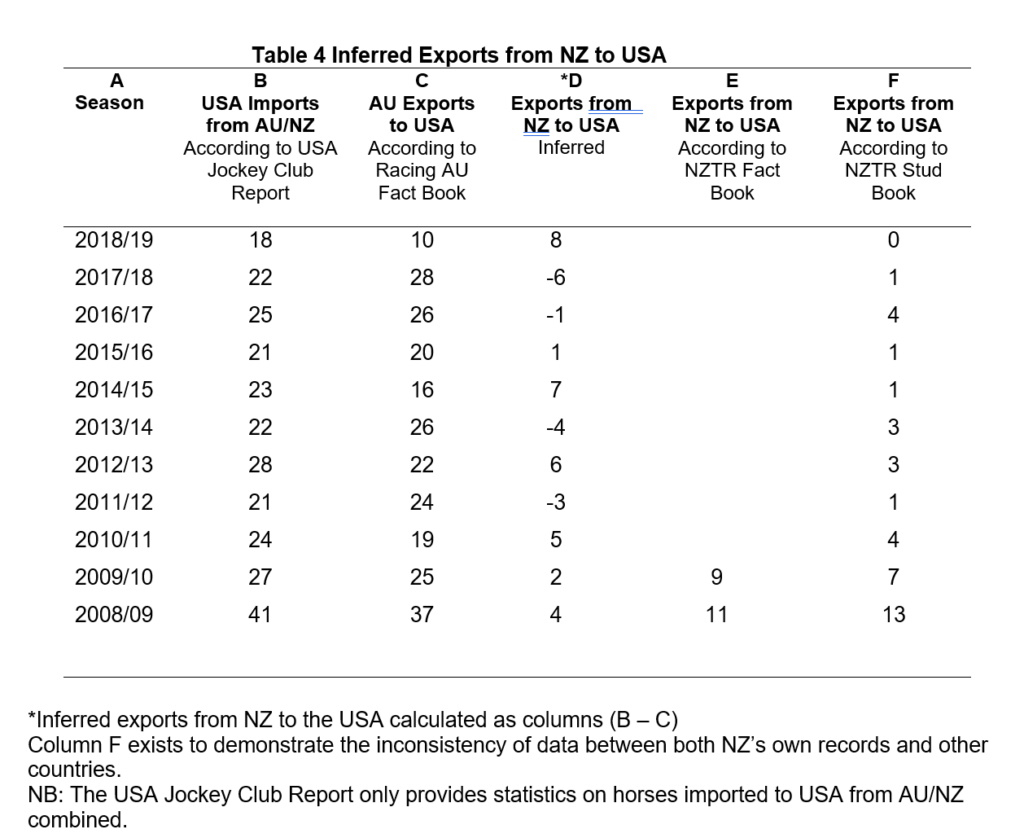
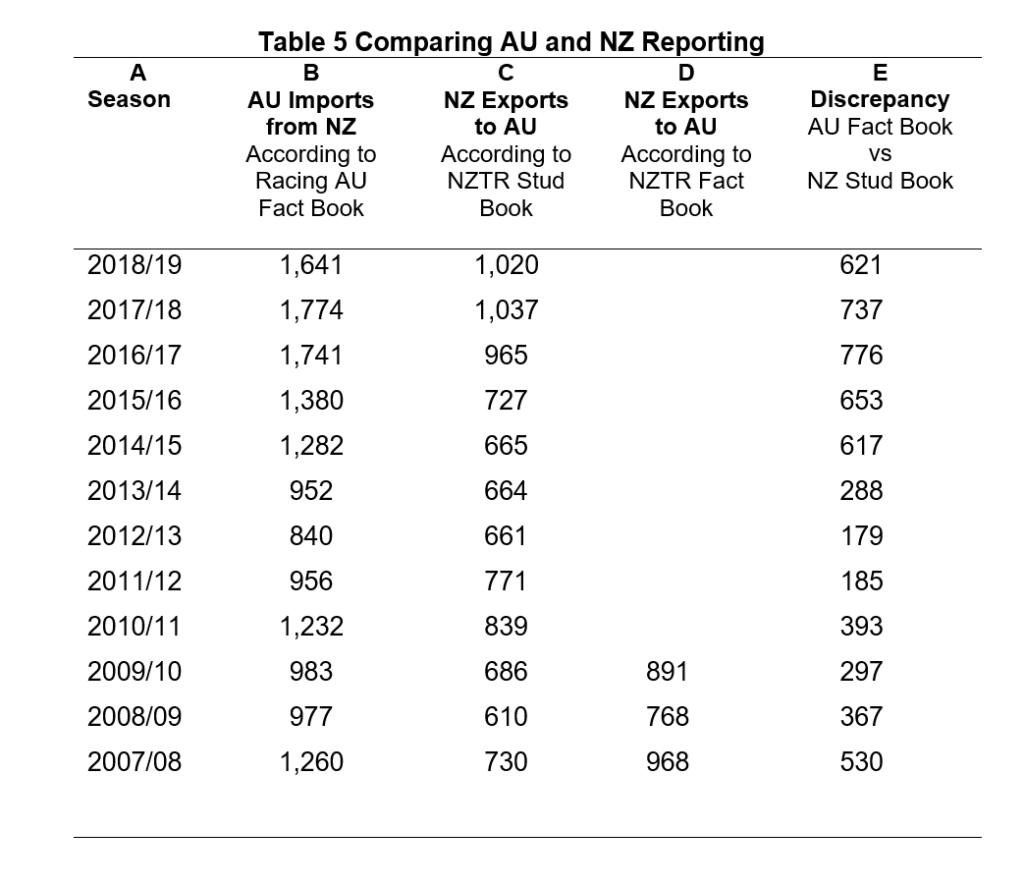
Conclusion
Similarly to Australia, the number of horses bred into the New Zealand Thoroughbred Racing industry each year is the approximate number of horses who vanish from the industry each year without a trace.
The New Zealand Thoroughbred Racing website states:
Individual thoroughbreds can be easily identified by their brands and microchips listed in the New Zealand Studbook. However, it is difficult for New Zealand Thoroughbred Racing to maintain reliable information on the location and ownership of horses that have been retired and re-homed with unlicensed owners, given unlicensed owners are not subject to NZTR regulatory oversight. Attaining ‘whole-of-life traceability’ for the New Zealand thoroughbred population is an objective which faces practical limitations
(Source https://loveracing.nz/welfare/population-traceability)
Approximately 3,500 foals are purposefully bred specifically for the New Zealand Thoroughbred Racing industry each year. On average, 3,191 thoroughbred horses are exiting the industry each year, with no data provided as to where these horses are going. The average lifespan of a horse is 25-30 years. The average time a horse is used for racing is 3 years. It is simply unacceptable for the industry to wipe their hands of their responsibility to these individuals once they are no longer of use to them and is yet another example of how bringing living beings into the world for the sole purpose of making profits will in most cases lead to unethical outcomes once those profits can no longer be made.
Horse racing supporters must consider what the likely outcomes are for over 3,000 unwanted horses each year and assess whether they want to continue to support an industry that not only forces these horses into years of isolation, being pushed well beyond their limits and using implements such as whips, bits, spurs and tongue-ties, but also routinely discards the very horses their industry could not exist without.
References
New Zealand Thoroughbred Racing Fact Book 2008, 2009, 2010
https://loveracing.nz/nztr/info-and-comms/nztr-publications
New Zealand Thoroughbred Racing Annual Report 2007-08, 2008-09, 2009-10, 2010-11, 2011-12, 2012-13, 2013-14, 2014-15, 2015-16, 2016-17, 2017-18, 2018-19
https://loveracing.nz/nztr/info-and-comms/nztr-publications
New Zealand Thoroughbred Racing Studbook
https://loveracing.nz/stud-book/search
International Federation of Horse Racing Authorities Annual Report 2007, 2008, 2009, 2010, 2011, 2012, 2013, 2014, 2015, 2016, 2017, 2018
https://www.ifhaonline.org/default.asp?section=Resources&area=2
Racing Australia Fact Book 2008-09, 2009-10, 2010-11, 2011-12, 2012-13, 2013-14, 2014-15, 2015-16, 2016-17, 2017-18, 2018-19
https://www.racingaustralia.horse/Aboutus/FactBook.aspx
The Jockey Club, Thoroughbred Import/Export Trends 2009 – 2019
http://www.jockeyclub.com/default.asp?section=FB&area=5


Thank you for your comprehensive expose’ of Thoroughbred racing in New Zealand!
It’s egregiously cruel for such young horses to be disposed of when no longer profitable or
unsuitable for the track! The numbers are staggering!
I rarely watch commercial tv, & turn off when sickening exploitive betting ads come on!
May exposure education and compassion counteract the Thoroughbred Racing Industries attempts
to recruit further gambling addicts for the future!
You could look at the horses registered in ESNZ and see how many are TBs ?
Also most polo ponies are TBs but i don’t know if they have a register.
We have a 22 yr old TB at home by Green Perfume. He is branded but I don’t think he raced.
My neighbour has a TB mare by Westminster who is about 8 or 9 so that is where one of them is.
https://www.facebook.com/eventstarstbs/
This is a FB page for rehoming TBs off the track. So some of them might have come through here.
What mostly shocks me is that living beings are called “wastage”! That animals can be simply thrown away like rubbish. To degrade a living being to a lifeless and worthless thing ! For me it sounds terrible and is absolutely incomprehensible! I just don’t understand this!!!!! How can it be that animals are killed easily just for greed and profit! A horse has feelings like a human, can suffer like a human – so it is easy to imagine what terrible fears and pains the animal can suffer. When coming to slaughter the horse will feel panic, it is sheer horror… Nothing to be proud of! This is a shame of man ! What is the matter with the human species?